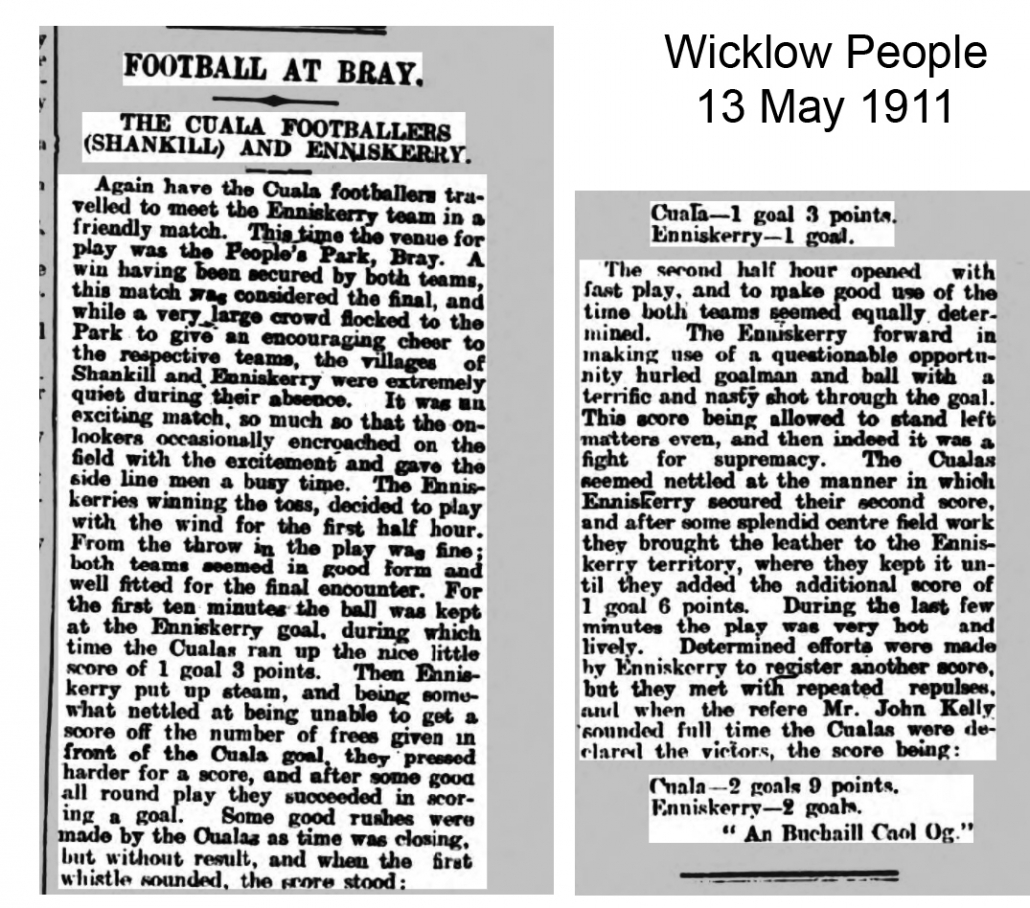Cuala Head For The Hills In 1911 – But All Is Not As It Seems
Players and spectators at Shanganagh & Bray Emmets may sometimes be distracted from the game in hand to view the beautiful scenery of the surrounding hills. A well-known landmark on the skyline is the Ballycorus Chimney and its nearby companion, Carrickgollogan Hill. Of course nobody from the immediate area would know that hill by any other name except “Katty Gallagher”. Nowadays, it a popular site for hill walking but, in times past, people tended not to walk for leisure but simply to get from A to B.

So back in the day, March 1911 that is, an observer might have been surprised to see more than the usual number of people traipsing up around “Katty” – boys and men mostly – passing along what was, even then, a quiet country lane. What was going on? Where were they all headed?
Our local observer would probably have recognised many of the faces as they made their way up the Quarry Road from Shankill and heading for Ballyman which would bring them within sight of their final destination – Enniskerry. There, a battle was about to commence, or rather resume. And our travellers went by the name of Cuala!
Now whatever about their precise purpose, the revelation of this planned encounter has caused considerable surprise for Cartlann Digiteach Cuala. Until now, we understood that the earliest “Cuala” team was the side that dated from the 1920s. That was the Cuala Hurlers who were active from the early 1920s. We even know that direct decedents of this team are active in Cuala to this very day (just ask Dayo or JP). But now, in 1911 that is, Cartlann Digiteach Cuala finds that, there was an even earlier team that bore the name “Cuala” and it wasn’t hurling. Nor were they from Dalkey or even Dun Laoghaire. What our reporter up at “Katty” had witnessed was a “Cuala” team en-route to play the second of a three-match series against Enniskerry – in Football. And that “Cuala” team hailed from – Shankill. (Match Report 1: Mar. 1911 below)
These “Cuala” Footballers had lost the first game, probably held on a sloping field near Puck’s Castle. The second had been arranged to take place on a field belonging to William Johnston, proprietor of the Leicester Arms Hotel (now the Enniskerry Inn). On this occasion, the Cuala Footballers won the day. A few weeks after the trip to Enniskerry, a decider was required and the third fixture was arranged in a neutral venue – the Peoples Park in Bray (Match Report 2: May 1911 below)
So where do these “Cuala” Footballers fit in the jigsaw of our own club’s history? Are they connected? And what became of them? Well, Cartlann Digiteach Cuala believes they might not have been officially called “Cuala” at all, or at least not for very long.
The term “Cuala” was used by many organisations. We had Cuala Press, Cuala Industries, Ceolteorai Cualann etc. But it was probably Conradh na Gaelige (The Gaelic League) more that any other group that caused the term “Cuala” to be so widely recognised. They even named their local Ceanntair (region) “Cuala” reflecting the fact that it encompassed Conradh Branches in all the parishes across the ancient Cuala territory that stretched from Kilcoole/Delgany/Sugarloaf to the Dodder. Being convenient transport hubs, the area committee met alternately in Shankill (Harcourt St. Rail line) and Dunleary (Coastal Rail line) for meetings. Initially set up to promote Irish language and literature, Conradh quickly expanded its objectives to include arts and crafts. They promoted drama too. In fact the Shankill Branch was one of the first to produce a 3-act drama,”Toradh na Tada“, that was performed in St Mary’s Hall on Eblana Avenue in April 1912.
Significantly, for our story, at its national Ard Fheis in 1902, Conradh adopted a policy of encouraging its Branches to set up Hurling, Football and Athletic Clubs in their areas. And Shankill rose to the challenge. A team called Shilmaliers had been active in Shankill since about 1887 but by the turn of the century, it had become dormant. So it was that, in 1904, under the leadership of many of those already involved in Conradh’s “Cuala” Ceantair, a team was “founded” – or more likely resurrected, using the same name as the former Shankill side – Shilmaliers. (Report 13 Apr 1904 below)
Cartlann Digiteach Cuala believes it was this team – comprising players and supporters so closely associated with Conradh that took part in those 1911 matches and that they had, adopted (or were reported as representing) Conradh’s “Cuala” brand. Whatever their reason, the real truth can be discovered in the Match Report 1 (below). Notice how their supporters encouraged the players with cry’s of “Go on Shills“. Later in 1911, the news reports tell us that Shankill footballers were again in operation again under their official “Shilmaliers” banner. In fact they continued to play under that title (or Shelmaliers in later times) until about 1921/22. For the record, the Shankill players in 1911 included –
- Frank Crawley (captain, Shankill – now Rathmichael)
- Pat McDonald (goals, Tillystown – now the modern village)
- William McGarry (Old Conna)
- James Murphy (possibly Leopardstown)
- William Hanlon (Shangannagh)
- John McGarry (Old Conna)
- James Kearns (Loughlinstown)
- Michael Rogers (Shankill)
- Robert Kearns (Loughlinstown)
- Terence Leonard (Loughlinstown)
- Francis O’Brien (Tillystown)
- Patrick Kearns (Loughlinstown)
- Robert Tobin (Shangannagh)
- Simon Doyle (Tillystown)
- Joe Murphy (possibly Brennanstown)
- Thomas Mahony (Shankill)
- Michael Reilly (Loughlinstown, son of a publican, probably from what was to become the Silver Tassie)
And speaking of Conradh, here’s another link between that organisation and our own Cuala. Conradh na Gaelige was founded by Douglas Hyde who later became first President of Ireland. And it was in his honour that Hyde Road Dalkey is so named and where the one and only Cuala is proudly headquartered today.



 Cartlann Digiteach Cuala (Cuala Digital Archive) maintains an on-line archive of images and stories relating to Cuala, its ‘ancestral’ clubs and other Gaelic clubs that once operated in its area. If you have any information or material to share with us, please contact –
Cartlann Digiteach Cuala (Cuala Digital Archive) maintains an on-line archive of images and stories relating to Cuala, its ‘ancestral’ clubs and other Gaelic clubs that once operated in its area. If you have any information or material to share with us, please contact –
Michael Goodwin, +353 (0) 87 2266140, history@cualagaa.ie




